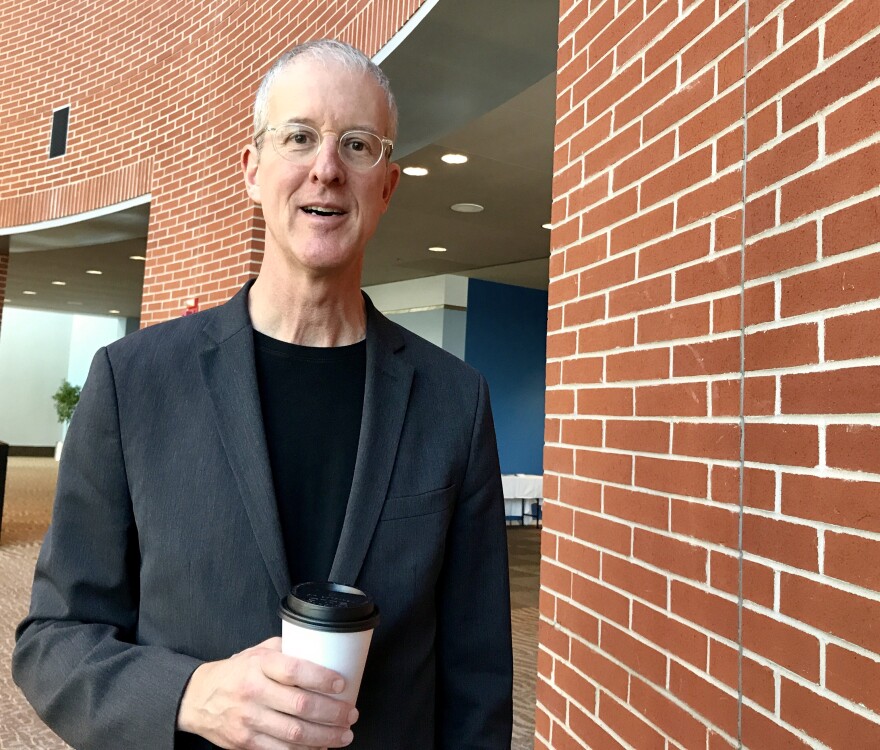Rebuilding Akron as a 21st century city could mean overhauling zoning codes, embracing its historical architecture and putting city streets on a diet – by narrowing freeway-size lanes to pedestrian friendly paths. Those were among the steps highlighted at a conference at the John S. Knight Center today on ways to rebuild the city’s population to 250,000 by 2050. WKSU’s M.L. Schultze spoke with one of the national urban planners who focuses on the attraction of cities.
Jeff Speck advocates for walkable cities, so much so that the title of his book claims they could save America. But he also advocates for bikes and even cars in a city that understands how they can work together. Speck preached that message the last time he came to Akron seven years ago, and says one of the biggest changes he’s seen since then is dedicated bike lanes downtown. There’s also the decommissioning of the innerbelt highway.
“You also see the very strange condition of Highway 59 having been vacated, which was a good move, although I should say the real move would have been not to build it in the first place.
“And it’s a bit of a challenging opportunity because I’m a little concerned that investment in redeveloping that part of town would actually draw investment away from places where there’s more people and stuff.
Putting the innerbelt in its place
He acknowledges it’s 31 acres downtown. But “my point is that there’s a lot of missing teeth downtown; there’s a lot of streets downtown that need more attention. There’s a lot of stuff already happening in the city core where I think money could be better spent.”
So while he wouldn’t discourage someone from taking on the project, “I just wouldn’t want to see much public money going to it until we’ve focused on the heart of the city where the people are.”
Speck says the city is correctly focused on priorities like protected bike lanes, but needs to recognize that until there’s an extensive bike network in place – “that connects people to places they need to go” – downtown lanes will be under-utilized.
'Dozens of cities are realizing the mistake they made by turning these streets into essentially one-way freeways.'
But protected bike lanes make cities safer for everyone, he said, with accidents and injury accidents dropping by as much as 68 percent.
Two-ways and slower
He says while they slow things down, they also haven’t increased congestion.

"People are driving a little more calmly, but still signals are signals and they get through the signals with about the same speed that they did before. He says Akron’s also heading the right way be “reverting” one-way streets into two-way corridors.
“Dozens of cities are realizing the mistake they made by turning these streets into essentially one-way freeways” out of town.
Speck also wants Akron to fill in some of its “missing teeth,” especially the parking lot that fronts S. Main Street across from Canal Park.
'The gap across the street from your ballpark is the absolute worst place to have that parking lot. ... We call it a tear in urban fabric.'
“For some reason I have a real bone to pick; it’s bothered me more than most places in most cities. The gap across the street from your ballpark is the absolute worst place to have that parking lot. You’ve got almost a mile of streets with nice edges to it that just breaks open.
“We call it a tear in urban fabric.”
He says putting up building that occupies the front 60 feet of that lot up against the sidewalk “would fundamentally change the feel of the best part of your main street.”
Cities want millennials and millennials want cities. Why?
That urban feel, he says is what would attract millennials, more than three-quarters of whom say they want to live in an urban core. Speck acknowledges the contradiction since most of those millennials have grown up amidst suburban sprawl.
“I’ve often asked myself why does this generation that grew up more suburban than mine have such a longing to live in cities. … And I think it may be because their experience in the suburbs as children was kind of being captive, folks being chauffeured in cars they didn’t control. And I think may be they associate driving with that feeling of disempowerment.”
Jeff Speck says everything from shorter blocks to public art help create cities those millennials and others want to embrace because they do four things: They’re useful, safe, comfortable and interesting.





